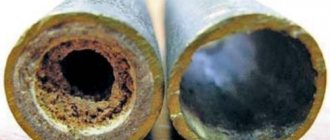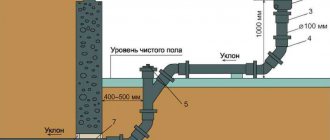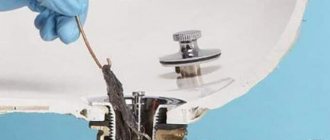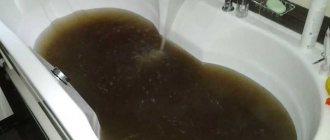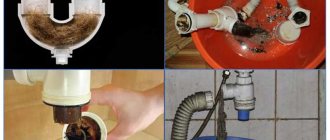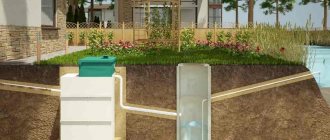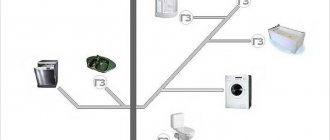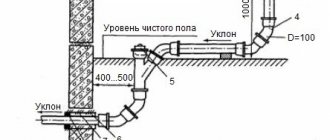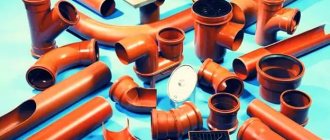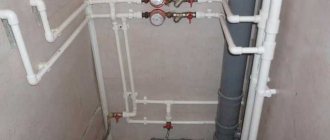In this article:
- Causes of blockages in the sewer system
- Methods for localizing blockages in sewer pipes
- 5 ways to clean drains at home
- Mechanical sewer cleaning equipment
- Advantages and disadvantages of mechanical sewer cleaning
- Cleaning sewerage in a private house using bacteria
- Advantages of hydrodynamic sewer cleaning
- Characteristics of equipment for sewerage cleaning using the hydrodynamic method
- Preventing blockages in the sewer system
- Professional help if you can’t clean the drain yourself
All sewer cleaning methods are varied. Their effectiveness depends on the complexity of the blockage, the types of equipment used and the cleaning conditions: apartment, organization, private house. If we are talking about household methods for removing blockages, then the most obvious method is using a plunger. Boiling water and chemicals are also often used.
However, simple methods of cleaning sewer pipes do not always provide long-term results. If the blockage is old, and after breaking through it, it forms again after some time, you should use methods using professional equipment. More details about everything in our material.
Use of chemicals
In addition to self-made mixtures, other methods of cleaning sewer pipes are used. Now any store can boast a huge selection of various chemical products specially created to remove blockages in the sewer. There are not only domestic products, but also foreign ones. There should be no doubt when choosing one or another product, since they all do their job perfectly.
The only caveat is that you just need to read the instructions before use, although usually all you need to do is just pour the solution into the pipe and wait a while.
Removing blockages mechanically
You can also break through a blockage in a pipe at home mechanically, using a brush, plunger, cable or metal wire with a brush at the end. The degree of sewer blockage will influence the choice of tool for the job. For example, a shallow blockage can be broken through using a brush - making sharp movements.
To clean pipes with a plunger, you need to perform the following steps:
- Place the tool over the drain channel.
- Open the water and fill the sink with enough water to cover the bowl of the plunger.
- Make sure there is no water under the plunger.
- Perform 15-20 vertical swinging movements without lifting the tool from the surface.
If all other methods of mechanical cleaning have failed, you will have to use a cable. However, this procedure is the most difficult. The cable is very rigid because it is made of twisted wire rolled into a rod with a cross-section of 3-5 mm.
The procedure for using the cable is as follows:
- first dismantle the siphon;
- the end of the cable with the handle is inserted into the sewer pipe and, turning it counterclockwise, is gradually immersed;
- during operation, the cable is periodically pulled out for cleaning;
- the procedure is repeated until the blockage is completely removed;
- At the end of the work, reinstall the siphon and rinse the system with hot water.
After cleaning, a test run of water is carried out. If it goes away quickly, it means the sewer is cleaned well. If not, you will have to repeat everything.
Cost of one-time sewer cleaning (Emergency removal of sewer blockage)
| Name and cost of the work package |
| Removing blockages in the building's internal drainage network. from 6500 rub |
| Elimination of blockages in the external (yard) drainage network of the building to the receiving well without pumping. from 12,000 rub. |
| Removing blockages in the external (yard) drainage network with pumping out the receiving well. from 18,000 rub. |
You can also order pumping out of grease traps and removal of concrete waste.
Use of household products
How to clean a drain? To answer this question, it is enough to remember the properties of various household products that everyone has in their home. The sequence described below will help clear the blockage in a short time:
- First you need to clear the drain hole of large debris.
- Next, fill it with one liter of very hot water and leave to soak for several minutes.
- Then you need to use a plunger.
- After several manipulations with the plunger, you can fill the hole with one mug of soda, and then pour boiling water into it again.
This procedure may be performed more than once.
Baking soda will help form an alkaline environment in the sewer pipes, which can remove blockages. In addition, it has excellent disinfectant properties. More details:
- You can also use this method.
- Soda is poured into the pipe in equal proportions and vinegar is poured.
- After the substances are mixed, foam forms, therefore, it is better to cover the drain well with something and forget about it for two hours.
- As a result, all that remains is to take out the stopper and pour boiling water over everything.
A mixture of salt and soda will also help prevent blockages at home. To create it you need:
- Both ingredients are mixed in equal parts.
- Boiling water is poured into the drain and the mixture is left for several hours. At this time, you cannot pour anything else into the pipe.
In general, in order to avoid the accumulation of debris in sewer pipes in advance, you need to pour boiling water into them from time to time, which easily dissolves not only grease, but also soap pieces.
In a private home, you can use the following recipe for flushing pipes:
- After mixing, a mixture of a glass of salt, a glass of soda and a quarter glass of cream of tartar should be poured into a well-closing container.
- This mixture must be poured into the drain from time to time and poured with boiling water.
- In just a minute, all that remains is to rinse the hole with ice water.
Prices for sewer cleaning
We provide sewer cleaning from RUB 5,000 and provide a guarantee for the service provided. We carefully select cleaning equipment that matches the size and type of your task, so you don’t have to overpay. Call and find out the exact cost of cleaning, we will leave in 10 minutes.
Why us?
- we really solve the problem efficiently and for a long time
- We have many years of experience, good specialists and all the necessary licenses
- we are recommended to friends and colleagues
- We will be with you within an hour anywhere in Moscow and the region
IMPORTANT . Even if you carefully operate the sewer system in a private home and do not flush foreign objects into it (hygiene products, packaging materials, large food waste), you will not be able to protect yourself 100% from blockages and periodically cleaning the sewer pipes is necessary for preventive purposes.
Urine stone, hard water, hair that is guaranteed to get into the system, fatty deposits - all these are factors that contribute to the formation of blockages. And so that one day the toilet does not turn into a geyser, or the bathroom does not accumulate feces to the brim, periodic cleaning of the sewer is required.
- Removing clogged toilets, sinks and bathtubs
from 4500 rub.
Order
- Removing clogs in the kitchen
from 4,500 rub.
Order
- Removing sewer blockage at the outlet of the building
from 8,000 rub.
Order
- Flushing storm networks
from 100 rub./linear meter
Order
What types of sewers do we service?
- cleaning of external sewerage and pipelines
- cleaning sewerage
- cleaning of storm drains and drainage pipes
- cleaning water pipes
- car wash cleaning
- We also carry out tele-inspection and video diagnostics of pipes
The Kanalservice service offers preventive and emergency sewer cleaning services in a private home (cottage, country house, etc.). Call and a team of specialists will come to you in 10 minutes. Removing sewer blockages in a private home from the Kanalservice company is quick, professional and profitable.
External sewer cleaning
Deposits form in external sewer pipes due to the properties of our water, regardless of correct operation, and this is a matter of time. After deposits form on the inner surface of the pipes, the process of pipeline contamination accelerates because the water flows into the main networks a little slower, and therefore sediment begins to form due to the decreasing flow speed through the sewer pipes. Sediment and deposits in pipes can rot, because these are excellent conditions for the growth of bacteria, so analyzes of discharged water will become worse and worse. Therefore, we recommend carrying out preventive sewer cleaning from time to time.
Sewage sewer cleaning
If you are now faced with this problem, then we understand that it is important for you to solve it as quickly as possible, call us and we will be with you within an hour. We solve the problems of cleaning sewerage of any size and scale: in the private sector, cottage, country house, we will clear the clogged sewer in an apartment building or just in an apartment. Of course, this happened due to improper use, someone threw away hygiene products or maybe thick paper. We hope that this will not happen again, and now we are ready to clean the sewer as quickly as possible.
Cleaning of drainage and storm sewer pipes
Storm drains are designed so that they can be cleaned without outside help, but sometimes they become clogged with tree branches, stones, creepers, leaves, sand and drain pipes need to be cleaned. We are perfectly adapted to solve this problem; we use several types of sewer cleaning, mainly hydrodynamic cleaning of pipes. We will do everything quickly, safely, efficiently and, of course, we will issue a guarantee for the work performed.
Mechanical cleaning
What to do if the pipe in the kitchen is clogged, and the time to carry out the cleaning procedure is limited? In this case, a mechanical method is used, implemented with a plunger and wire for cleaning pipes. A plunger is basically a household device that uses the principle of changing pressure in a pipe. In this way, blockages are often either completely removed or noticeably weakened. In the future, you can use the already familiar method of flushing the pipe with hot water. It does not require any special skills in handling the tool.
How to clean pipes in the kitchen if the blockages are deep enough? This is done using a special tool such as wire. It consists of a metal or wire rope, and at the end there is a kind of hook or tip in the form of a ruff. These devices are quite thin and flexible, which makes it possible to reach greater depths of the sewer system. Next, you will need to carry out rotational and translational manipulations, leading to the removal of the blockage by pushing it down the pipe.
If the cable has moved approximately two meters from the blockage, the work can be considered done: it is completed by traditional pipe flushing. To implement this method, in addition to having the plumbing cable itself, you will need certain skills, as well as information about the approximate location of the blockage. However, you can learn during the procedure itself.
Mechanical means
Mechanical cleaning agents are suitable for especially dense, persistent blockages.
The operating principle of the plunger is simple. It needs to be applied to the hole so that the rubber fits tightly to the sink, and with progressive movements to build up pressure in the pipe, it is under its action that the plug is removed. As soon as it becomes sufficient, it will clear the pipe from the most stubborn blockages and grease. In addition, it does not take up much space and can be stored for a long time, waiting in the wings, without being seen.
The most effective method remains a plumbing cable. It comes in lengths from 10 to 50 meters. A stiff brush is attached to one end and a handle to the other. The cable is lowered into the pipe until it hits a blockage, and then they begin to clear it by rotating the handle. Most likely, you will have to make some effort. Remaining deposits should be washed off with plenty of water.
To increase the efficiency of a hand spinner, you can use a drill. This will save effort and time.
To combat particularly difficult congestions, steel belts are used. They are equipped with comfortable handles and different attachments for more efficient work.
Mechanical methods only remove fatty deposits, but do not disinfect pipes. To do this, you should additionally use special tools.
You will find more detailed information about cleaning sewer pipes in the article - How to clean the sewer and remove the blockage with your own hands
How to unclog a kitchen sink
Every home has a sink in the kitchen or bathroom, which, unfortunately, is prone to clogs. Such a nuisance creates a lot of inconvenience - it interferes with work and most often spreads an unpleasant odor.
The cause of the blockage may be food debris or small objects that could get inside due to the lack of a protective mesh in the sink. The waste decomposes and forms grease deposits inside the pipes. Another reason is errors in installing the drainage system. If you have such a problem in your kitchen, don’t panic and call specialists, because you can solve the problem yourself. So, what to do if your kitchen sink is clogged?
Methods for cleaning sewer pipes
To decide how to remove blockages in sewer pipes, you must first find out where exactly the stagnation occurs and for what reason.
In cases where there is only a slight deterioration in pipe capacity, you can solve the problem yourself. But in very difficult cases it is advisable to call a specialist.
The following are the main methods of cleaning pipes:
- mechanical;
- chemical;
- hydrodynamic;
- folk methods - soda and vinegar; soda, salt and boiling water.
It is worth noting that with the help of folk tricks at home, everyone is quite capable of getting rid of blockages and odors from pipes.
If you decide to clear blockages in pipes using folk remedies, you can do this in one of the following ways:
Soda and boiling water. To do this, you need to dissolve a glass of soda in three glasses of boiling water and fill the pipe with this solution. Soda and salt. For cleaning you will need half a cup of baking soda dissolved in water and the same amount of salt. The entire composition must be left in the pipe for 10 hours to interact with the blockage. Soda and vinegar. Half a cup of soda and vinegar should be poured into the drain hole and, covering it with a stopper, wait 2 hours
In this case, be careful as mixing the ingredients leads to a violent reaction.
Application of cable
Sometimes debris gets clogged somewhere deep in the pipes, and then you have to use special equipment.
Typically, such a tool for plumbing work is a cable. It is created from steel wire and is made in the form of an elastic spring. At one of its ends there is a convenient handle for comfortable use, and at the other there is a spiral on which all sorts of replaceable attachments such as a hook, a ruff and many other items can be attached. In a private home, such a thing is simply irreplaceable for removing debris from pipes.
Using a cable for cleaning.
Before you start using the cable, you need to perform several preparatory steps:
- First, you should visually inspect the instrument and check its integrity.
- Then the strength of the grip handle is checked.
- The bushings from which the handle is made are lubricated.
- Each nozzle is inspected for problems.
If everything is in order, you can start cleaning the pipes:
- Taking the cable by the handle, its opposite end must be pushed into the pipe. Moreover, it is better to remove the siphon in advance, which will allow for more thoughtful cleaning.
- Next, you should turn the cable, pushing it as far as possible. If everything is done correctly, the translational movements performed will give the cable the opportunity to go around all the bends and bends. The main thing is not to put too much pressure on the cable, otherwise it may break.
- When the blockage is detected, all that remains is to rotate the cable more intensively. Such manipulations will quickly push through the rubbish. And if you chose a nozzle in the form of a hook, then you need to pull the rubbish out into the light.
- When the water begins to drain, you can run hot water first under weak pressure, and then more and more.
- The formation of a funnel will indicate that everything has been done correctly and the pipes have been cleaned.
Conclusion
Thus, using one of the methods described above, you can easily clean pipes in a private home. If the pipes become clogged, you can always contact a specialist, but doing everything yourself will be much faster.
More materials:
Characteristics of equipment for sewerage cleaning using the hydrodynamic method
There are portable cleaning equipment, and there are industrial, more powerful units that are powered only from the car engine (and placed on its chassis) or from a three-phase network.
Some cleaning devices run on propane. Electric machines are usually used to clean internal sewers, while propane and gasoline units are used when it is necessary to flush external pipes (in places where there is no access to the electrical network).
Drain cleaner attachments work in different ways:
- Punch-type nozzles are needed to break through a hard plug.
- Using bottom nozzles, layers of silt, sand and dirt are removed from the bottom of the reservoir.
- Chain carousels are great for removing debris, grass roots and other small items.
- Rotary nozzles are needed when eliminating fat deposits.
- Universal ones are used for periodic cleaning of sewers using a hydrodynamic method, which allows you to flush them out of other types of blockages.
The following technical parameters are important for a hydraulic cleaning machine:
- The water pump should have a water flow of 10-12 l/min. - this performance is quite enough to wash thin - up to 110 mm in diameter - sewer pipes in private houses, wiring in apartments and storm channels.
- The maximum level of operating pressure created in the pipe.
- Type of food. In those places where it is possible to connect to the city electrical network, units with an electric motor can be used. If this is not possible, choose a propane or gasoline-powered device.
- A hose with a length of 30 m if the machine will be used for washing long routes, and up to 15 m for compact mini-washes for household use.
- Sufficient engine power for the pump to build up pressure, which can be used to clean pipes of significant diameter.
It is recommended to carry out such flushing of sewerage in an apartment or at a summer cottage at least every eight to ten years. If the pipes are clogged, it is necessary to urgently call specialists who will promptly clean the household sewer using a suitable method.
Using a plunger
A common way to clean a drain is to use the well-known plunger. The genius of this invention is undeniable. The blockages, after the pressure created by the plunger, either begin to move further along the pipe and collapse, or come out, where they can be easily reached and eliminated.
A good result from working with a plunger will be achieved if it is used properly. You should follow the steps below:
- If the pipeline in a private house has an overflow hole, it needs to be closed with something. This manipulation will not reduce the level of pressure on the blockage.
- The plunger should be pressed tightly with the rubber part against the hole.
- Then you need to rhythmically make forward movements.
- As a result, you need to rip the plunger from the hole with a sharp movement.
Correct execution of all steps will allow you to clean the pipe in several approaches.
Causes of blockages
Cleaning the sewer system in a private home is necessary if there is an unpleasant odor coming from the sink. Also, the need for such work is indicated by a decrease in the rate of water drainage in plumbing fixtures.
Basically, sewer pipes can become clogged due to several reasons:
- Items. A large object gets into the drain and blocks the flow of liquid through the pipeline.
- Organic waste. Due to clogging of the sewer pipe with organic and inorganic waste that settles on their walls.
- Soap. Its particles, falling into the drain, mix with other waste and settle on the walls. As a result, they quickly harden and cause serious blockages.
- Fat. It is able to accumulate on the walls, gradually reducing their throughput.
- Hair. Over time, a lot of them accumulate, which causes a blockage that can only be removed mechanically or chemically.
Errors in the design of the sewer system. It is unable to function normally, and frequent blockages are guaranteed.
Hard water. It provokes the appearance of dense plaque on the walls of pipes, which is a common cause of blockages.
Cast iron pipes. They become clogged because they are susceptible to corrosion, which leads to the appearance of irregularities on the walls where grease and other household waste get stuck. By using plastic pipes this problem can be avoided.
Effective methods
How to break through a sink and clean out a sewer pipe at the same time? There are a lot of proven methods. The duration of action, the price of special means and the amount of effort expended are their main differences. So that you can choose the best method, I will present you the most effective ones.
Available means: 6 ways
In order to properly clean the pipe without damaging its structure, you should first resort to the simplest methods.
The instructions presented in the table will tell you how to clean the kitchen sink using improvised means:
| Image | Description |
| Method 1. Hot water For plastic pipes, washing with hot water is suitable. Turn on maximum hot water pressure for 10 minutes. | |
| Method 2. Soda You can clean the drain with a large amount of soda. Pour a packet of baking soda into the drain hole and leave for 30 minutes. Then drain some water. | |
| Method 3. Salt A dense plug of fat and food waste can be removed with ordinary table salt. Pour one large glass of salt into the drain and immediately fill it with the same amount of water. | |
Method 4. Soda + salt
| |
Method 5. Soda + vinegar
| |
| Method 6. Washing powder Pour 2 scoops of powder (example in the photo) into the drain and turn on the water supply for 5 minutes. The loose clog will disappear. |
Mechanical cleaning: 3 methods
Now let’s find out how to clean the drain in the kitchen using special plumbing tools:
| Image | Description |
| Tool 1. Plunger How to use a plunger? The mechanism is quite simple:
| |
Tool 2. Plumbing cable
| |
Tool 3. Wrench and screwdriver
|
Chemical cleaning: 2 products
You can also clear the clog using aggressive household chemicals. Such products are available in liquid and bulk form. Instructions on how to use them correctly:
| Image | Description |
Remedy 1. Powder
| |
Remedy 2. Liquid for blockages
|
Sewerage in an apartment - its features and effective cleaning methods
In apartments of communal residential buildings, they try to place all plumbing fixtures and the toilet as close as possible to the central riser; the outlet or corrugation from the toilet is connected directly to it.
Therefore, the length of the apartment sewer line is small, and the pipeline itself is installed mainly from 50 mm gray polyvinyl chloride (PVC) or polypropylene (PP) pipes.
Therefore, solving the problem of how to clean a sewer in an apartment has several simple and affordable options.
A plunger is mainly used to clear kitchen drains from small, unrelated particles of food waste. Fat deposits on the walls of pipes, as well as hair and animal fur in the bathroom, are removed using household chemicals.
If a plug has formed in the pipeline, a spiral-shaped plumbing cable is used, the length of which is several meters, which is quite sufficient to eliminate the blockage in any remote area.
Rice. 5 Possible places for blockages in apartment sewers
How to clear clogged bathroom pipes at home
How to clear clogged pipes in the bathroom at home using a plunger? The bathroom, unlike the sink, is equipped with a safety drain hole. It must be closed before cleaning. Using a plunger, a hydraulic shock is generated, which displaces the accumulation of dirt down the pipe from the narrow place of the drain, where a blockage most often forms. First, you need to fill the bath with enough water to cover the cup of the plunger. Place the plunger over the drain hole, press it tightly to the hole and sharply press the handle 3-4 times and sharply remove the plunger from the water. Repeat if necessary until water begins to flow freely.
You can clean the bathtub with a brush, for which you insert it into the sewer hole and use sudden movements to break through the clog that has formed. If necessary, you can attach a brush to a flexible rod to extend the structure and reach the blockage at great depths.
If a plumbing cable is used for cleaning, the siphon is turned out and the cable is inserted into the drain hole as deeply as possible. At the same time, it is rotated in both directions. Screwing into the pipe, the cable clears all blockages, the debris moves down the drain and is washed out. At the end of cleaning, all elements of the drain channel are washed and the siphon is cleaned.
If you don’t have wire or cable on hand, you can take an electric drill or screwdriver, which can also effectively help deal with the blockage.
Now let’s look at how to clear clogged pipes at home using traditional methods safely and effectively. Baking soda is great for this purpose. This is the cheapest and easiest method that any housewife can use without waiting for the help of a plumber.
You need to take soda and vinegar in equal proportions, for example, one glass each. Soda is poured into the drain hole and then vinegar is poured on top. The hole is closed with a stopper and left in this state for 2-3 hours, after which the pipe is washed with hot water. This method of clearing blockages is completely safe for pipes. It can be used not only to remove existing blockages, but also for prevention.
Let's look at a few more solutions made from soda that will help get rid of the blockage. To do this, take about 150 g of soda and heat it in a cast iron frying pan for about 15 minutes. After it has cooled completely, dilute it with a glass of water and stir thoroughly. This composition can be compared in effectiveness with the well-known store-bought chemical “Mole”.
Another safe way to clean your drains is using regular lemon. To do this, take a few lemons and squeeze them directly into the drain hole. Let sit without opening the water for at least an hour. If you don't have lemons, you can use half a cup of lemon juice concentrate. This method is also quite effective.
If a blockage of grease has formed in the sink, you can prepare a strong salt solution. It is poured directly into the drain hole and they begin to clean the drain with a plunger. To ensure a better fit of the plunger, its edges can be lubricated with an inexpensive cream.
A simple blockage in the drain can be removed with a powerful vacuum cleaner using its blowing function.
Do-it-yourself sewer cleaning - basic methods
Solving the problem of how to remove a blockage in a pipe cannot be attributed to the competence of narrow or general specialists; in most situations, any owner or even a housewife can cope with the problem. In addition, carrying out cleaning yourself will help save the family budget, because the services of a plumber are quite expensive for the average person with average incomes.
Rice. 7 Types of plumbing cables - rope, tape, spring, reinforced tension
Mechanical
Mechanical cleaning of pipes is used to remove dense plugs that completely clog the passage channel. Since this situation does not arise so often in communal apartments, rarely do any owners think about purchasing a special plumbing cable for this purpose. Therefore, they are classified as a professional instrument, which has several varieties:
Cable cars. These are elastic flexible cables of long length made of wire twisted into bundles, which are often used by employees of government organizations to clean communications in cities and residential villages. Due to their low rigidity, they are not widely used in everyday life.
Spring (spiral). Cables made of rigid spirally wound wire, having a handle on one side and allowing the use of various types of attachments on the other end (ruff, lance, spiral, whisk). Available in various lengths, usually no more than 10 m, due to their high efficiency and relatively low cost, they are ideally suited for domestic use.
There is also a reinforced version of spring cables, where the spiral is wound onto a rigid central core of a rope type.
Tape. Expensive devices in the form of a narrow strip of hard and elastic metal, designed for use by professionals. Their distinctive feature is the ability to manually clean pipelines at significant distances from the place where the device is immersed. Equipped with a handle and nozzles for punching plugs.
Tension. Powerful and heavy cables for professional cleaning of pipelines. They consist of several metal spirals of different diameters wound on top of each other in a counterflow. Due to their high rigidity and strength, they allow you to remove blockages in the sewer pipe at a considerable distance from the point of supply. Like spring types, they are used with various types of nozzles.
Rice. 8 Mechanical sewer cleaning using professional spring equipment
There are many varieties of manual plumbing cables, including simple spirals with a handle to drum-type devices that can be connected to a power tool to rotate them.
A separate group of plumbing cables includes electromechanical devices powered from the mains voltage, in which the spiral is fed using an electric motor. These are professional devices that can significantly facilitate and speed up mechanical cleaning work.
Operations for cleaning a household sewer pipeline with a plumbing cable are carried out in the following sequence:
- Remove the siphon under the bathtub or sink, and then insert the cable into the inlet of the pipeline.
- Using the handle, they perform a rotational movement while simultaneously feeding the spiral forward.
- As soon as they encounter an obstacle, the number of revolutions is increased to break through the plug. In other situations, they try to push the spiral deeper and pick up the object with a special attachment in order to pull it out.
- If a plumbing cable is used to clean the walls of a pipeline complete with a brush attachment, the penetration is carried out several times in the forward and reverse directions while simultaneously rotating the handle.
- To increase efficiency, immediately after cleaning and installing the siphon, turn on hot water and wash the walls of the pipeline.
Some specialists or DIYers do not resort to removing the siphon and prefer to clean the sewer through the drain holes of sinks or bathtubs. In this case, a more elastic spiral of small diameter is used without any nozzles with simultaneous supply of hot water.
With some stretch, plumbing cables can also include their polymer analogues in the form of narrow tapes with teeth, designed for extracting hair and fibers from the drain holes of bathtubs and showers.
Rice. 9 Polymer cables for removing hair and fibrous contamination
Hydraulic
Hydraulic sewer cleaning methods include the use of plungers. There are a huge number of their varieties in the trading network, which are quite difficult to classify. The main designs are elastic rubber hemispheres with handles of various shapes and piston-fed devices. In the first case, the plunger moves water masses in the forward and reverse directions through the pipeline over a certain distance.
Piston (pneumatic) devices move water by supplying air. This method makes it possible to push water masses over long distances with high pressure, which can lead to the elimination of dense traffic jams.
There is a group of plungers specifically designed for removing clogs in toilets, which use nozzles with an elongated neck instead of a sphere.
It is clear that the range of action of plungers is quite wide and they are designed to remove blockages specifically and are not suitable for cleaning pipeline walls.
Rice. 10 Types of plungers
To remove a blockage in a pipe using a regular plunger, proceed as follows:
- Pour hot water into the bathtub or sink until a certain volume is filled. If the water drains too quickly or the volume of water flow is small, close the drain hole with a stopper.
- Place a plunger on the drain and make back-and-forth movements with the handle several times.
- Periodically, the device is removed, filling the pipeline with new water masses, without turning off the water supply tap.
- Dirt floating in the water from the cleaned pipes is removed and disposed of.
To simultaneously clean the walls of the pipeline from dirt deposits and grease, you can add various detergents and washing powders, caustic soda to the water.
Rice. 11 Cleaning sewers using pneumatic and pistol plungers
Related article:
How to clean a pipe at home - reasons, methods, remedies . There is a separate article on our website about how you can clean a pipe yourself. Methods, methods, tools, read it, it might be interesting.
Hydrodynamic
Hydrodynamic cleaning methods use water jets directed at high pressure at a certain angle onto the inner walls of the pipeline. This method is most effective for eliminating various deposits on the internal pipe shells; with a sufficiently high pressure, it can also be used to break through plugs.
How to prevent clogged drains
Of course, it is much easier to take timely precautions than to clean the sewer pipes later. The following activities should be carried out:
The following activities should be carried out:
- Regularly, at least once every two weeks, the drain should be washed with boiling water;
- chemicals, household and food waste should not be thrown into the toilet or sink;
- use a fat separator.
Vinegar and soda can be used to periodically flush cast iron and plastic pipelines. In some systems, it is enough to create conditions for a powerful flow of water to keep the pipes clean.
On sale you can find chemical pipe cleaners in the form of gels or granules, which prevent grease from accumulating on the walls of the sewer. It is advisable to clean the drains with vinegar about once a week.
Fat separators are a very useful invention. They are mounted under the sink on the drain hole.
The operating principle of such a separator is as follows:
- First, water with grease and debris passes through the first filter, where rough cleaning occurs.
- Fat accumulations are retained on the second filter, so that relatively clean water is drained.
It is worth noting that prevention methods significantly extend the life of the sewer pipeline and relieve owners of many difficulties, from an unpleasant odor to complicated water outflow.
Prevention
The saying that trouble is always easier to prevent than to eliminate is a truth, although worn out, but fair. In order not to find yourself in an unpleasant situation at the wrong time, it is recommended to take a set of measures:
- replace old cast iron communications with PVC products;
- do not throw foreign objects into the toilet;
- install a mesh to catch large particles, or better yet, a waste shredder (disposer) under the kitchen sink: it will prevent clogging and reduce the amount of garbage - to find out how to choose a disposer, follow the link;
- Clean at least once a month with soda or special products;
- Clean the siphon three to four times a year.
These actions will be enough to protect you from unpleasant deposits.
